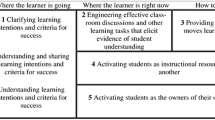Abstract
In the world of higher education, participating in academic assessment has become an inescapable part of every faculty member’s job description. While theatre faculty members have an inherent understanding of what artistic growth looks like, we may not always be effective in measuring that growth in an assessment context. This chapter utilizes best practices in assessment to demystify the assessment process. Utilizing theatre-specific vocabulary, the chapter walks theatre practitioners through the basic steps of developing student learning outcomes, curriculum maps, developmental assessment rubrics that effectively measure specific program outcomes, and assessment plans. While most assessment literature ends with the collection and analysis of data, this chapter goes beyond to demonstrate methods that theatre practitioners can use to “Close the Loop” in their assessment cycles. By closing the loop on assessment data, theatre practitioners can recognize opportunities to develop innovative curriculum changes to help their students achieve the goals of the program. By fully completing the assessment cycle, theatre programs can reward innovation, better articulate program values, develop dynamic student-centered curriculum, and implement strategic program development.
Access this chapter
Tax calculation will be finalised at checkout
Purchases are for personal use only
Similar content being viewed by others
Notes
- 1.
Bloom’s Taxonomy of Learning Domains, created in 1956 by educational psychologist Dr. Benjamin Bloom, was designed to promote higher forms of thinking rather than just rote learning. Lists of Bloom’s action verbs ranked according to levels of learning are easily found online. (www.bloomstaxonomy.org).
- 2.
Competency-based curriculum uses the phrase “curriculum mapping” to emphasize how a student progresses through the program towards a specific program-goal. In most cases, this demonstrates for the student that if they take course X, course Y, and course Z they will build skills and advance to degree completion.
- 3.
Performance analysis can be part of this outcome, as it is still text-based.
- 4.
We recognize that this outcome is a compound sentence, but typically oral and written communication go hand in hand.
- 5.
Note that many assessment professionals emphasize that evaluating student work at the programmatic level is more effective if done anonymously, and this process belies that. However, because this type of assessment is only one piece of the overall assessment pie, it is certainly acceptable.
References
“Assessment and VALUE”. Association of American Colleges and Universities. http://aacu.org/resources/assessment-and-value. Accessed 3 Nov 2016.
Association for Theatre in Higher Education Task Force. 1990. ATHE Outcomes Assessment Guidelines for Theatre Programs in Higher Education, White Paper. http://c.ymcdn.com/sites/www.athe.org/resource/resmgr/imported/OutcomesAssessment.pdf.
Ball, William. 1984. A Sense of Direction: Some Observations on the Art of Directing. Hollywood: Quite Specific Media Group.
Banta, Trudy W., and Catherine A. Palomba. 2015. Assessment Essentials: Planning, Implementing, and Improving Assessment in Higher Education. San Francisco: Jossey-Bass.
Combs, Charles Edward. 2001. Accessing Institutional Planning Through Accreditation and Assessment. Theatre Topics 11 (1): 81–87.
Kuh, George D., Stanley O. Ikenberry, Natasha A. Jankowski, Timothy Reese Cain, Peter T. Ewell, Pat Hutchings, and Jillian Kinzie. 2015. Using Evidence of Student Learning to Improve Higher Education. Jossey-Bass: San Francisco.
Strategic National Arts Alumni Project. snaap.indiana.edu. Accessed 10 June 2017.
Suskie, Linda. 2009. Assessing Student Learning: A Common Sense Guide. San Francisco: Jossey-Bass.
Author information
Authors and Affiliations
Corresponding author
Editor information
Editors and Affiliations
Rights and permissions
Copyright information
© 2018 The Author(s)
About this chapter
Cite this chapter
Duncan, J., Griffin, B.W., Malone, T. (2018). Theatre Assessment for Teaching and Learning. In: Fliotsos, A., Medford, G. (eds) New Directions in Teaching Theatre Arts. Palgrave Macmillan, Cham. https://doi.org/10.1007/978-3-319-89767-7_6
Download citation
DOI: https://doi.org/10.1007/978-3-319-89767-7_6
Published:
Publisher Name: Palgrave Macmillan, Cham
Print ISBN: 978-3-319-89766-0
Online ISBN: 978-3-319-89767-7
eBook Packages: Literature, Cultural and Media StudiesLiterature, Cultural and Media Studies (R0)




